The SLAM Robots Market is estimated to be valued at USD 363.6 million in 2025 and is projected to reach USD 3552.6 million by 2035, registering a compound annual growth rate (CAGR) of 25.6% over the forecast period.
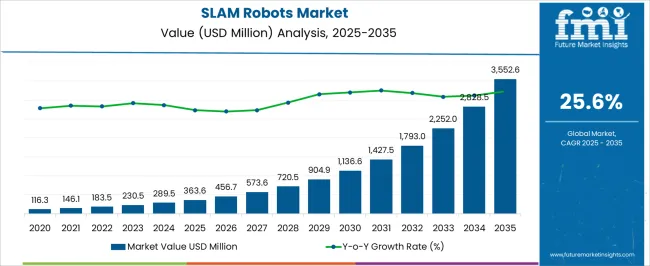
| Metric | Value |
|---|---|
| SLAM Robots Market Estimated Value in (2025 E) | USD 363.6 million |
| SLAM Robots Market Forecast Value in (2035 F) | USD 3552.6 million |
| Forecast CAGR (2025 to 2035) | 25.6% |
The SLAM robots market is advancing steadily as industries increasingly prioritize automation and precise spatial awareness. The rising adoption of robotics for navigation and mapping tasks, especially in complex environments, is being propelled by technological advancements in sensors and computing power.
The shift toward autonomous systems in sectors such as manufacturing, logistics, and service robotics is accelerating demand for efficient simultaneous localization and mapping solutions. Emerging trends indicate that improvements in algorithm accuracy and integration with AI are enabling SLAM robots to perform with higher reliability and adaptability.
Furthermore, growing investments in robotics research and expanding applications in indoor environments are expected to fuel future market growth. The focus on enhancing operational efficiency and reducing human intervention in navigation tasks is creating significant opportunities for innovation and deployment across various industries.
The market is segmented by Offering and Application and region. By Offering, the market is divided into Graph-Based SLAM, EKF SLAM, and By Type. In terms of Application, the market is classified into Indoor Navigation, Unmanned Aerial Vehicle (UAV), Augmented Reality (AR)/Virtual Reality (VR), and Others. Regionally, the market is classified into North America, Latin America, Western Europe, Eastern Europe, Balkan & Baltic Countries, Russia & Belarus, Central Asia, East Asia, South Asia & Pacific, and the Middle East & Africa.
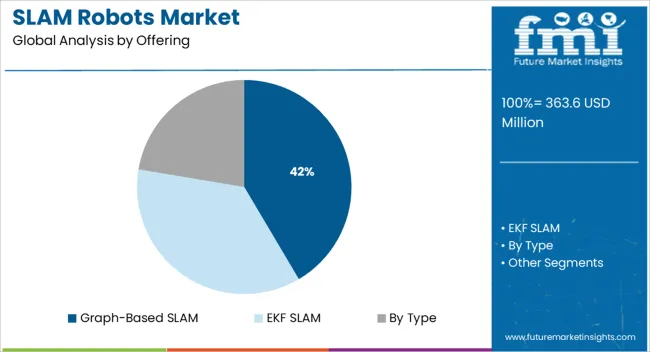
The graph based SLAM segment is anticipated to command 41.5% of the total market revenue in 2025, establishing it as the leading offering. This position has been supported by its ability to efficiently manage complex spatial data through graph optimization techniques, which enhance the accuracy of mapping and localization in dynamic environments.
The robustness of graph based methods in handling loop closures and large-scale maps has made it a preferred choice for applications requiring precise navigation. Advancements in computational algorithms have further improved processing speed and resource efficiency, facilitating its deployment in resource-constrained robotic platforms.
The widespread adoption of graph based SLAM has also been reinforced by its compatibility with various sensor configurations and its adaptability across diverse operational scenarios, solidifying its dominance within the market.
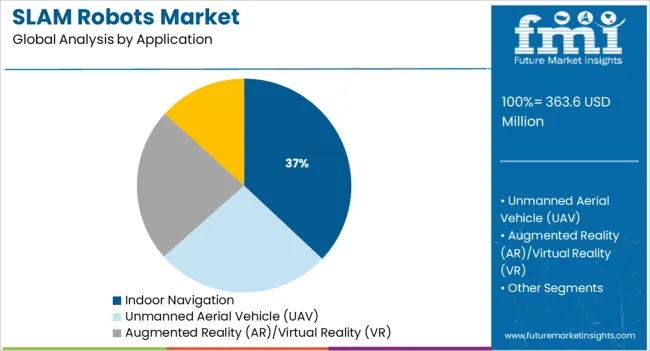
In terms of application, indoor navigation is projected to hold 37.0% of the market revenue share in 2025, making it the foremost application segment. This leading share has been driven by the increasing use of SLAM robots in enclosed and GPS-denied environments such as warehouses, hospitals, and retail spaces.
The demand for autonomous navigation solutions that can operate reliably in complex indoor settings has necessitated sophisticated mapping and localization capabilities, which SLAM technology delivers effectively. Additionally, the growth of e-commerce and warehouse automation has intensified the need for efficient indoor robotic systems to optimize logistics and inventory management.
Indoor navigation applications benefit from advancements in sensor fusion and real-time data processing, which improve robot performance and safety, further establishing this segment’s preeminence in the market.
The SLAM Robots Market is estimated to grow at a CAGR of 25.3% for the forecast period compared to the historic CAGR for the period 2020 to 2025 of 18.2%.
Increasing utilization of automated robots across a variety of industry verticals is estimated to accelerate the adoption of SLAM robotics in the coming future. The use of SLAM robots for managing and transporting containers and packages of products is already a practice in large enterprises and developed countries, this technology could percolate into developing countries and small enterprises further during the forecast period.
Companies and industries are relying more on technology to improve the output of their processes and reduce the errors that are caused by human workers, apart from that, automation software and devices assist human workers in improving the efficiency of their work. SLAM robots have various applications in the industrial sector that help in the improvement of operations, driving the market for SLAM robots.
The North American region is analyzed to dominate the global SLAM robot market with a share of 26.7%in 2025 and the South-Asia Pacific region is estimated to grow at the fastest rate with a CAGR of 27.8% during the forecast period of 2025 to 2035.
Growing applications of SLAM technology in defense, logistics, and industrial sectors combined with the presence of major market players namely Amazon Robotics and Apple are the key factors influencing the market dominance of the SLAM robot market in the North American region.
Rising trend towards industrial automation, increasing advancements in robotics, and the rising emphasis on the adoption of autonomous home appliances gadgets. These are some of the significant factors analyzed to positively impact the growth of the SLAM Robot Market in the South-Asia Pacific region in the coming years.
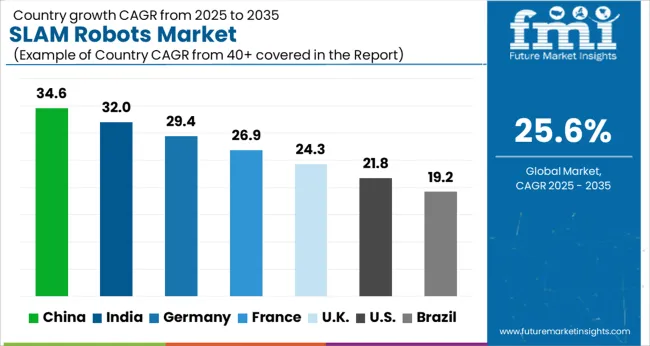
Due to technological advancements in the past, good infrastructure for the adoption of SLAM robots as most industries have already shifted to certain levels of automation, and so on, the United States was estimated to dominate the global SLAM robot market with a share of 15.7% in 2025.
Furthermore, rising potential applications for SLAM robots in the e-commerce industry, shopping malls, construction sites, healthcare, and other sectors are significant factors driving the country's high adoption rate.
During the global pandemic of 2024, the adoption rate of robots and smart home appliances skyrocketed due to the increasing emphasis on contactless services and social distancing. Factors such as the widespread use of robots for targeted medicine delivery, sales, e-commerce, and surveillance are the key factors accelerating the adoption of SLAM Robots in China.
Due to these factors, the Chinese SLAM robot market is estimated to grow at a CAGR of 26.5% over the forecast period.
Increasing skill development initiatives, student scholarships for RD in the field of science and technology, as well as programs like AI for India, AI Ideathon, and Make in India are some of the key factors encouraging technological innovations in the development of advanced robotics in India, thus encouraging the development and adoption of SLAM robots in India and allowing the market to grow at a CAGR of 28.1% in India.
Graph-based SLAM Robots can be implemented at low cost with relatively inexpensive cameras and they can also be used for detecting landmarks thereby ensuring a high level of precision. Such factors are leading to the widespread adoption of graph-based SLAM technology in varied industry verticals, this technology can also be implemented for underwater exploration increasing its application for navigational purposes.
For these reasons, graph-based slam robots held the largest market share of 41.7% for 2025 by type.
Based on the offerings the two-dimensional segment is analyzed to dominate the SLAM Robot Market with a share of 59.3% in 2025, owing to the factors such as increasing application of 2D sensors in various appliances, less complexity associated with the implementation of 2D SLAM technology as compared to the 3D SLAM technology and so on. Furthermore, 2D SLAM technology is being widely used in industrial robots for direction mapping, localization, and motion planning. These are the key factors behind the increased market share of 2D SLAM Robots.
SLAM Robots' market share for the Augmented Reality (AR)/Virtual Reality (VR) application is estimated to grow at the fastest rate with a CAGR of 28.9% during the forecast period of 2025 to 2035. Some factors behind this market growth are the growing use of SLAM technology in AR applications for object recognition and overlay digital interactive augmentations, along with the rising utilization of SLAM in autonomous robots, home appliances, machines, and so on.
Additionally, the inability of the GPS to provide a high level of precision and its failure to work in enclosed spaces have accelerated the adoption rate of SLAM robots for various applications. Such factors are expected to boost SLAM Robots' market share for Augmented Reality (AR) and Virtual Reality (VR) applications in the coming years.
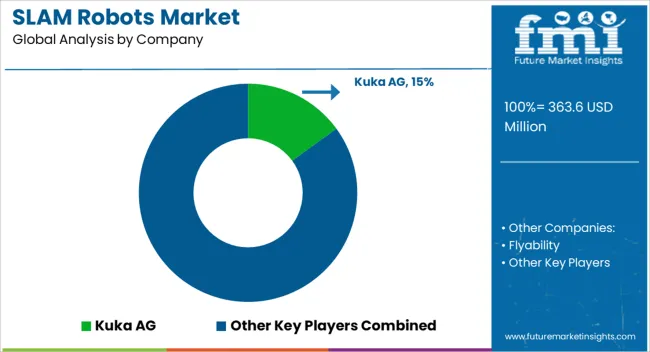
Currently, the SLAM technology is being developed for robots among technology companies to improve the functioning of self-driving cars and unmanned aerial vehicles (UAV), the technology is also being developed for medical and surgical purposes.
| Attribute | Details |
|---|---|
| Market value in 2025 | USD 363.6 million |
| Market CAGR 2025 to 2035 | 25.3% |
| Share of top 5 players | Around 40% |
| Forecast Period | 2025 to 2035 |
| Historical Data Available for | 2020 to 2025 |
| Market Analysis | USD Million for Value |
| Key Regions Covered | North America; Latin America; Europe; South Asia & Pacific; East Asia; and the Middle East & Africa |
| Key Countries Covered | USA, Canada, Germany, UK, France, Italy, Spain, Russia, China, Japan, South Korea, India, Australia & New Zealand, GCC Countries, Turkey, and South Africa |
| Key Segments Covered | Type, Offering, Application, and Region |
| Key Companies Profiled | Flyability; Amazon; Apple; Microsoft; Intel Corporation; Clearpath Robotics Inc.; Kuka AG; Geoslam; Slamcore; Slamtec |
| Report Coverage | Market Forecast, Company Share Analysis, Competition Intelligence, DROT Analysis, Market Dynamics and Challenges, and Strategic Growth Initiatives |
| Customization & Pricing | Available upon Request |
The global slam robots market is estimated to be valued at USD 363.6 million in 2025.
The market size for the slam robots market is projected to reach USD 3,552.6 million by 2035.
The slam robots market is expected to grow at a 25.6% CAGR between 2025 and 2035.
The key product types in slam robots market are graph-based slam, ekf slam and by type.
In terms of application, indoor navigation segment to command 37.0% share in the slam robots market in 2025.






Full Research Suite comprises of:
Market outlook & trends analysis
Interviews & case studies
Strategic recommendations
Vendor profiles & capabilities analysis
5-year forecasts
8 regions and 60+ country-level data splits
Market segment data splits
12 months of continuous data updates
DELIVERED AS:
PDF EXCEL ONLINE
Micro Robots Market Analysis - Size, Share, and Forecast Outlook 2025 to 2035
Delta Robots Market
Mobile Robots Market Size and Share Forecast Outlook 2025 to 2035
Pharma Robots Market Size and Share Forecast Outlook 2025 to 2035
Nuclear Robots Market Size and Share Forecast Outlook 2025 to 2035
Kitting Robots Market Size and Share Forecast Outlook 2025 to 2035
Milking Robots Market Size and Share Forecast Outlook 2025 to 2035
Airport Robots Market Size and Share Forecast Outlook 2025 to 2035
Painting Robots Market Size and Share Forecast Outlook 2025 to 2035
Security Robots Market Size and Share Forecast Outlook 2025 to 2035
Military Robots Market Size and Share Forecast Outlook 2025 to 2035
Surgical Robots Market
Pipetting Robots Market Size and Share Forecast Outlook 2025 to 2035
Logistics Robots Market Size and Share Forecast Outlook 2025 to 2035
Inspection Robots Market Size and Share Forecast Outlook 2025 to 2035
Dispensing Robots Market Size and Share Forecast Outlook 2025 to 2035
Palletizing Robots Market Size and Share Forecast Outlook 2025 to 2035
Therapeutic Robots Market Size and Share Forecast Outlook 2025 to 2035
Educational Robots Market Analysis by Type, Application, and Region Through 2035
AI Assisted Robots Market

Thank you!
You will receive an email from our Business Development Manager. Please be sure to check your SPAM/JUNK folder too.
Chat With
MaRIA